Unplugged: Holiday Guide 2014
 Give the gift of face to face time with a boardgame. It’s time once again for me to preach to the masses on the greatness of boardgaming. Nothing beats the social aspect of in-person gaming with friends. Last year’s run-down of recommended boardgames was a great success. Here again are some great examples of boardgames to get you and your family gaming. You might not find all these titles at your local mega-mart but many can be found online or in a friendly local game store. Those new to the world of boardgaming may find a bit of a sticker shock as some games are pricier than new release video games, but good boardgames will provide many more hours of entertainment than most video games. Boardgames are also relatively timeless so they can be pulled out years from now and provide the same level of enjoyment. In that vein, feel free to delve into some past year’s guides for 2012, 2010, or 2009. For each game I’ve provided the number of players, retail price, and expected time for one game. Note that often these games can be found for 20-40% less than the MSRP.
Give the gift of face to face time with a boardgame. It’s time once again for me to preach to the masses on the greatness of boardgaming. Nothing beats the social aspect of in-person gaming with friends. Last year’s run-down of recommended boardgames was a great success. Here again are some great examples of boardgames to get you and your family gaming. You might not find all these titles at your local mega-mart but many can be found online or in a friendly local game store. Those new to the world of boardgaming may find a bit of a sticker shock as some games are pricier than new release video games, but good boardgames will provide many more hours of entertainment than most video games. Boardgames are also relatively timeless so they can be pulled out years from now and provide the same level of enjoyment. In that vein, feel free to delve into some past year’s guides for 2012, 2010, or 2009. For each game I’ve provided the number of players, retail price, and expected time for one game. Note that often these games can be found for 20-40% less than the MSRP.
Kids
Games suitable for kids old enough to sit still and play, but contain enough interesting activity to entertain adults.
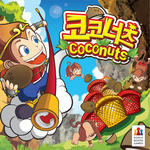 Coconuts (2-4p, $36, 20 min)
Coconuts (2-4p, $36, 20 min)
Possibly my favorite game of the year, this crazy dexterity game has players taking turns to use catapult monkeys to launch Milk-dud sized plastic coconuts into cups in the center of the board. Success allows one to claim a cup for their own stack. First to six cups wins, but watch out for players gunning for your own cups rather than the center ones.
Catan: Junior (2-4p, $30, 50 min)
Perhaps the best-known modern boardgame is Settlers of Catan. This edition slims down the game play with kinder, gentler rules and fewer “fiddly bits”. Players try to build pirate bases linked by ships (instead of roads.) A great game for kids as young as 4, it serves as a great stepping stone to the full Settlers of Catan game.
Pirate’s Blast (2p, $20, 10 min)
You haven’t experienced all that kid games have to offer until you’ve spent a few minutes trying to fight off your opponent using basting bulb powered cannons. Each player has rubber “basting” bulb used to “puff” their pirate ship around the game area. After each turn, the opponent gets to try to shoot the enemy ship via a small wooden cube loaded into a cannon and “launched” via a puff of air from their bulb. If the enemy ship avoids contact, they get another turn. Play proceeds until one player manages to tag their opponents island enough times to steal all their treasure.
Party
The more, the merrier! Here are a few games that can accommodate at least 6 players and, unlike some games, tend to be more fun with more players.
 Dixit (3-6p <or 3-6 teams>, $35, 30 min)
Dixit (3-6p <or 3-6 teams>, $35, 30 min)
A great twist on the classic Apples to Apples. One player (the story-teller) draws a beautifully illustrated card from a deck and then makes up a phrase to describe a single it. Players then select one of their cards they think best matches the phrase. All the cards are placed in the center and players try to guess which card is the storyteller’s. The cards are beautiful and have an amazing variety of evocative images.
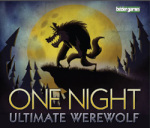 One Night Ultimate Werewolf (3-10p, $25, 10-30 min)
One Night Ultimate Werewolf (3-10p, $25, 10-30 min)
You may be familiar with the popular group game Werewolf or Mafia. A few players in a group are selected as the werewolves/mafia and then several rounds occur where the wolves eliminate people at “night” and then all the people vote a new person out of the group. The wolves win if they reach a majority of the group, the rest win if all the wolves are eliminated. The game is so popular that many variations have been created where each person may be given one of many special villager or werewolf roles. One Night Ultimate Werewolf is a spin on the old game, including the special roles, but it doesn’t need a moderator and it plays in one single round. A handy, free companion app exists both on iOS and Android .
Family
As your family gets older, they’ll have more fun with games with a bit more “punch”. Games in this category are playable by most any age level (so even the young ones can participate) but have enough strategy so that the older players have a chance to use strategy to increase their chances of winning.
 King of New York (2-6p, $52, 40 min)
King of New York (2-6p, $52, 40 min)
King of Tokyo is my sons’ favorite game. Players take on a role of a monster with some minor special powers and then roll dice, somewhat Yahtzee style, in order to score points, earn energy to buy more powers, attack other players, or heal up. The game lasts until all but one player is eliminated (usually) or one player scores 20 points (less often.) King of New York is the sequel, providing much of the same dice-rolling gameplay, but adds in a bit more strategy through the presence of multiple game locations as well as buildings to smash and armies to defeat. Players earn points for bumping off buildings and armies, but need to stay weary of both other monsters and of army attacks. The series are dice rolling games that are family fun, approachable by younger players, and are quick to play. Fans of the first game as well as parents of pre-teens or older will appreciate the slightly more strategic sequel, King of New York.
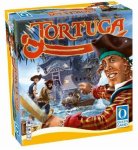 Tortuga (2-4p, $50, 30 min)
Tortuga (2-4p, $50, 30 min)
A favorite of my two young boys, Tortuga is a pirate themed game with a dice placement mechanic. Players roll their dice (each face has a symbol and numerical rating), setting aside at least one each turn by placing them on the appropriate spot on the game board. Once all players’ dice have been rolled, the board spaces are evaluated. The player with the highest total at each space gets to perform that action, while the second place player gets a minor bonus. The goal of the game is to draft treasures off one’s island, push them through their pirate loading crew, and then carry them via ship to their stash. Game spaces add new treasures at one’s island, allow invasions of other player’s pirates or ships, or replenish one’s supplies of ships and pirates. The whole game works well as a family game. There is a bit of strategy, but between the random die rolls and the ability of players to “gang up” on others the game allows everyone at least a chance to come out a winner. Due to the “pick-on-the-leader” nature of the end game, I don’t recommended it for older or experienced gamers, but even young school aged kids can play (and it is far and above better than anything you’d find for that age group at Mega-Mart.)
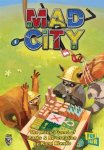 Mad City (1-6p, $35, 20-30 min)
Mad City (1-6p, $35, 20-30 min)
A very fast-playing tile placement game. Each player is dealt a stack of 9 tiles and must make a 3×3 square within the time limit. After the time limit ends, players evaluate their scores. Tiles display symbols of several colors and points are scored for each separate colored area, based on the number of connected symbols present. The first player to complete their grid scores bonus points for parks and lakes, but the rest of the players get to use the rest of the time to continue to optimize their layout. The game is simple to explain, plays fast, and its semi-solo competition prevents hard feelings that might occur in games where one child attacks another.
Family Strategy
These are great games for most families – or a group of adults looking for a medium-weight game to play casually around the table to end an evening. These are a notch up in complexity kid’s or party games, but are simple enough for teens or preteens to enjoy.
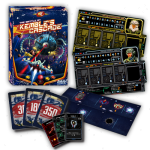 The Battle at Kemble’s Cascade (1-5p, $50, 45+ min)
The Battle at Kemble’s Cascade (1-5p, $50, 45+ min)
My favorite game of the year is pure nostalgia. Remember those old shoot-em-up arcade games? This boardgame is a faithful recreation of that experience. Players take on the role of a space ship, slowly equipping it with more and better weapons and equipment. Meanwhile they are piloting their ships through a board made of 4 rows of cards. Each round, the bottom row is removed and a new one is created at the top. In this way, the board “scrolls” past the players. Players can shoot up ships and items on the board to earn points and money. Shooting other players is allowed, of course, and the biggest source of points is when other players die – everyone still on the board scores 2 points. Dieing is no big deal, as no upgrades are lost, and the player returns to the field on their very next turn. Just like the old arcade games, there is a giant “boss” ship in the last few lines of the board which needs to be fought before the end of the game. While it might not appeal to every boardgaming fan, it is a worthy boardgame for anyone who has the slightest nostalgia for arcade shooters. (Although my young boys demonstrate that any fan of spaceships will also appreciate the game.)
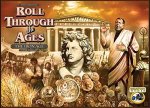 Roll Through the Ages: Iron Age (1-4p, $45, 30-45 min)
Roll Through the Ages: Iron Age (1-4p, $45, 30-45 min)
One Holy Grail of boardgaming is to create that sort of civilization-building experienced seen in Advanced Civilization (the boardgame inspiration for PC Civ games) but in a much more reasonable time frame. Roll Through the Ages: Iron Age does a fairly good job of capturing the fun of developing a nation in a short 30 minutes of dice rolling. Players can pursue one of two routes – growing ports or creating provinces – both of which increase the number of dice one can roll. Ports provide goods which can be used to buy new developments (special abilities) while provinces provide armies which can go to war for points. However, provinces must be fed food each round. Players have three tries to reroll their basic dice which provide food, goods, instant “cash”, and people. One special die provides and “event” and it can be rerolled as well. If a skull is ever rolled on a die, it must be saved and a disaster occurs that cost points. At the end of the game points are scored for developments, monuments (built with rolled workers), armies, and conquests. It doesn’t have the depth of a long civilization game, but it packs an impressive amount of civ-building in a short period of time.
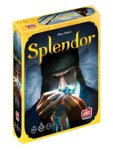 Splendor (2-4p, $40, 30 min)
Splendor (2-4p, $40, 30 min)
Players purchase gems (displayed in three rows) to create the best collection. On a turn, a player may take 3 different color chips, two of the same color, or use one’s chips to buy a gem card. Each gem card has a different listed price (ex: 1 blue, 1 green, and 2 red) but when purchased provides a “bonus” gem value, reducing all further purchases including that color. Players continue purchasing cards, with cards in more expensive rows worth more points. The first player to reach 15 points wins. The game is somewhat abstract (the theme is not a strong one), and I’m not yet positive of the depth of strategy available. However, I am impressed at how much of a gem-buying engine I can construct in such a short game.
Serious Gamer
These are games for the more serious boardgamer. These have a few more rules and take a bit longer to play. However, they can be the most satisfying games to play for those willing to spend the time sitting at the table.
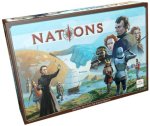 Nations (1-5p, $100, 120 min)
Nations (1-5p, $100, 120 min)
The longest of this guide’s recommended games, Nations is an involved Civilization building game, but also provides a satisfying Civilization-type experience. Players start with some basic abilities but then can buy cards from a central tableau to adjust and upgrade their abilities. These abilities must then be activated by spending ore to place a worker (a limited resource) on the card. These cards improve a player’s income of resources and points. The game plays over 8 rounds, with some scoring and more powerful cards appearing every other round. In addition to improvements, cards can be purchased that provide an advisor or colonies (which provide ongoing bonuses), wars, and monument cards. Monuments are the most powerful cards, typically with ongoing effects. However, monuments need to be built over time with significant amounts of ore. One aspect I appreciate about Nations is the use of armies and warfare. Rather than direct aggression, a player who sacrifices production for a large army gains indirect benefits. This avoids the problem of constant attacks on the weakest player. Not all the cards are used in any one game, giving each game an individual feel. The game also comes with basic, advanced, and expert cards with more advanced cards providing more complex interactions. The game also has a fun solo mode where one plays against a set of randomized tiles that represent a “programmed” opponent. While the game has pieces for up to five players, I highly recommend capping it at 4 due to its increased length with more players. While I have not fully explored the varied strategies and experiences found within the game, I look forward to continued plays.
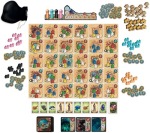 Five Tribes: The Djinns of Naqala (2-4p, $60, 60 min)
Five Tribes: The Djinns of Naqala (2-4p, $60, 60 min)
Using an innovative Mancala-type mechanism, Five Tribes is a beautifully produced strategy game of collecting and placing little workers. The board consists of a randomized grid of tiles on which are placed three workers (commonly called Meeples). During their turn, a player picks up all the meeples on a tile and then deposits them one worker per space (Mancala-style) as they move around the board. Players must deposit their last worker on a space containing one or more matching meeples. Depending on the color of the last meeple placed, an action is performed. The more same-colored meeples on the final spot, the more powerful the action. If the removal of the meeples leave the tile empty, additional points or advantages are scored. The game is interesting due to the variety of actions that can occur – depending on the color of meeples removed. Some provide instant points, some give points later, and some provide resources of another type. One color allows the purchase of a Djinn tile, which gives a player new ways to bend the rules in specific ways. The various types of Djinns (only a small fraction are seen each game) give the game its style and keeps it interesting. The game’s primary drawback lies in the large number of options on a player’s turn. Some players may find it initially overwhelming and it can quickly bog the game down in slow decisions. If played quickly, it remains an entertaining game full of fun options.
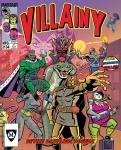 Villainy (3-4p, $50, 60 min)
Villainy (3-4p, $50, 60 min)
Villainy would normally miss my top suggestion list, but it’s theme requires a mention. Players take on the role of a villain and try to amass henchmen and other improvements in order to carry out their grand villainous plan. The theme is quite strong, players are given a nifty little board full of dials with which to keep track of their people. This board is appropriately decorated with switches and lights that fit in with the dials to make a great looking villain lair. It falls square in the gamer-game category due to its length, however the mechanics may fail to be sufficiently strategic for a more seasoned gamer. This results in a fun game for those who are going to enjoy the theme as they play, but a milder recommendation to those who are not already predisposed to the theme.
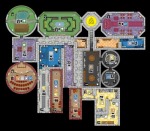 Castles of Mad King Ludwig (1-4p, $60, 90 min)
Castles of Mad King Ludwig (1-4p, $60, 90 min)
In Castles of Mad King Ludwig, players attempt to create the ultimate castle (by scoring points.) Players acquire rooms which must then be assembled in such a way as to maximize their scoring. The trick in this game lies in how new rooms are acquired. Each round, the active player sets a price for each available piece and players then either purchase a piece (giving the cash to the active player) or pass and receive more cash from the bank. The game continues until the pile of rooms is exhausted, and players score what they built. It is a fun game that requires a bit of spatial planning. However, many of the rooms give special bonuses so the active player needs to keep track of many details when trying to set their prices. To me, it has the feel of a family strategy game, but I place it in the gamer-game category due to the need to keep track of the many interactions of rooms on the board.
Stocking
Got a bit of space left in the toe of your sock over the fireplace? Here’s a couple of great small games that come with a small price to boot.
 Animal upon Animal: Small and Yet Great (2p, $7, 15 min)
Animal upon Animal: Small and Yet Great (2p, $7, 15 min)
This kid’s dexterity game is also fun for adults. Players take turns stacking small animals upon a central crocodile figure. Knock some over and you have to pick them up. The first person to run out of pieces wins. This is a nice, tiny implementation of the popular Animal upon Animal line of games. The box is small, but you could put the pieces in a bag and carry them easily in your pocket.
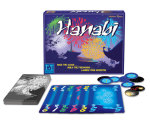 Hanabi (2-5p, $11, 20-30 min)
Hanabi (2-5p, $11, 20-30 min)
A cooperative card game for those who love games like Clue or Mastermind. The deck consists of cards displaying numbers 1 to 5 in five different colors. The game’s unique gimmick lies in how player hold their cards – visible only to the other players. The players must help each other out in order to place the cards in five central piles in the correct sequence. On a turn, a player may play a card, provide another player a hint about their card(s), or discard. A hint must either indicate all cards of the same color or of the same number in another player’s hand. For example, if I tell you that you have one 4 and there is only one pile showing a 3, you might surmise that I want you to play the card on the exposed 3. Hints are initially limited, but discarding a card grants the team back another hint. There are duplicates of some, but not all cards so players must be careful about what they discard. The game is “lost” after the third incorrect play (a card placed on the wrong stack or in the wrong order.) It is very hard to “win” the game, but it is fun to try. Not a game for players who hate to think, but an easy hit for those who like logic or deduction games.
Role Playing Games
Role Playing Games have surged in popularity in the past couple of years. If someone in your life shows a leaning towards imagination, creativity, or storytelling, an introduction to the world of role playing games might be in order. Here are a few examples spanning a wide variety of types and recommended ages.
 Dungeons and Dragons: 5th edition
Dungeons and Dragons: 5th edition
The big news from Wizards of the Coast is the newest edition of Dungeons and Dragons. This 5th edition takes a few of the innovations of the 4th edition but attempts to capture the simplicity and faster game play of earlier editions. The easiest way to get to know the system is through the Starter Set ($20) – a box set containing a basic manual of rules, an adventure, and a set of premade characters (even set up so they can “level up” during the adventure.) The rules book in the starter set also serves as a great rules reference for gamers who end up buying the entire 3 rule book set. The Player’s Handbook, the Monster Manual, and the Dungeon Master’s Guide ($50 MSRP for each book) form the complete set of source books for the new system. Along with the new rules release, two linked adventure modules (Hoard of the Dragon Queen, The Rise of Tiamat – $30 MSRP each) form a “first adventure” taking characters all the way up to level 14 or 15. While all these books seem pricey (they can be found cheaper) what should catch peoples’ eyes is the entirely FREE PDFs of the basic rules http://dnd.wizards.com/articles/features/basicrules. Yes, anyone can download all the rules for creating characters and running games for absolutely nothing. Only four core character classes are provided, with one “flavor” of each one. However, there is information on the classes and spells all the way to 20th level. The one omission is in any example “monsters” – although information is provided on how to design your own. The free rules can easily be used with published adventures, at least until your group gets into the game enough to want to spring for the books.
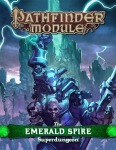 Pathfinder
Pathfinder
The currently, the most popular RPG is Pathfinder – a rules set with its initial beginnings in the 3.5 edition of Dungeons and Dragons. While several supplements have been released this year, my favorite is the huge adventure, The Emerald Spire Superdungeon. This adventure takes characters from 1st to 13th level through 16 different large levels of a dungeon – each level was written by a different luminary from the RPG game world. The entire 160 page adventure is $25 in PDF form, but in Paizo tradition there are additional things on offer for those with more money than time. For $80 ($56 for PDF) one can get eight double-sided Paizo Flip-Mats covering all 16 dungeon levels. These mats are excellent quality, laminated to repel wet and dry erase markers. If that isn’t enough, Campaign Cards ($11) are available which have pictures of NPCs, write-ups of important magic items, and cards that summarize important quests in the adventure. While dungeon crawls aren’t for everyone, fans of the genre will have plenty to push through with this mega-adventure.
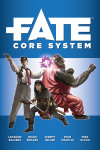 Fate Core
Fate Core
Lately, there has been a movement for role-playing games to emphasize the storytelling aspects and lower the importance of rolling dice. The Fate Core rules (available as PDF – name your own price, $5 suggested) emphasize storytelling with a few lightweight rules for adding in dice rolls for additional tension. I love the system’s primary goal for players and game masters: “Make everyone look awesome!” Other than storytelling the two main mechanics rely on “Fudge Dice” (six sided dice with +, -, and blank faces) and on Fate Tokens. To perform an action, players roll four dice and add up the plusses, subtract the minuses, and add in bonuses they have for any appropriate skill. The more total plus signs rolled, the more impressive their success. (Lots of minuses result in spectacular failures.) The Fate Tokens are tied to players’ chosen aspects (like “tempted by shiny things”). Players gain a Fate Token whenever their aspect requires them to perform a detrimental action. Players can use Fate Tokens whenever they can use their aspect to accomplish something useful. If you want a pleasant evening based around storytelling and don’t want to be bogged down by details of combat, Fate Core (and the many available settings and supplement books) just might be the thing for which you’re looking.
 Lone Wolf Development
Lone Wolf Development
Technically not an “unplugged” element, but gamers looking to use the magic of the computer to help run their role playing games should check out Lone Wolf Development. They make the Realm Works ($50) software which has a plethora of tools for a game master to create a world and manage stories and adventures. Hero Lab is their program for players looking to manage their character creation and progression. For $30, gamers are given access to one game system, as well as several free-to-use systems. Systems include Pathfinder, Savage Worlds, Mutants and Masterminds, 4th Edition D&D (one of the free ones), as well as the ability to make a custom system. I found the program to be easy to use, but the ongoing costs of continuing to purchase digital rights to newly published Pathfinder material prohibitive. The other systems were not as pricey. The best feature of the system is the freely downloadable iOS program (currently only Pathfinder rules.) While anyone can use the app for free, its best features kick in when one also owns the Hero Lab program.
Other
Finally we come to the “other” category, typically a catch-all of things amusing to me that aren’t quite boardgames. This year my favorite non-game item was our family’s interest in toppling dominoes.
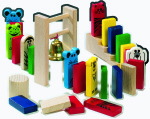 Two good candidates are the HABA Domino Race Set ($75 for 240 dominoes) or Domino Rally ($22 for 150 dominoes). While the HABA set is a bit pricier, it’s made of wonderful wooden pieces that are great for building or knocking down, the type of toy that will survive for grandchildren to use. The Domino Rally set is much less expensive, the pieces are smaller and lighter, and made of plastic. However, the Domino Rally set has several “set” pieces like loops and other tricks that make it easy to set up some cool effects. Both options are good choices. It depends on your situation.
Two good candidates are the HABA Domino Race Set ($75 for 240 dominoes) or Domino Rally ($22 for 150 dominoes). While the HABA set is a bit pricier, it’s made of wonderful wooden pieces that are great for building or knocking down, the type of toy that will survive for grandchildren to use. The Domino Rally set is much less expensive, the pieces are smaller and lighter, and made of plastic. However, the Domino Rally set has several “set” pieces like loops and other tricks that make it easy to set up some cool effects. Both options are good choices. It depends on your situation.
Conclusions
No matter what toys and presents the holidays bring, be sure to keep time in your schedule for playing with friends and family. While the games here come highly recommended to provide fun for a wide range of players, there are plenty other choices available. Ask your local game store, check some of our past recommendations, or swing by the BoardGameGeek Gift Guide.
Matt Carlson writes about boardgames for GamerDad.com and OpinionatedGamers.com. He has one of the first YouTube channels on science at www.YouTube.com/ScienceTheater and can be followed on Twitter under the username: ScienceTheater.

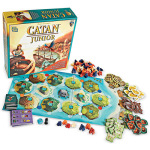
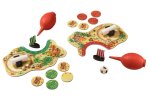




November 29th, 2014 at 12:31 am
Hi Doc C! Love the list- lots of great gift ideas! Kevin and I really enjoy Hanabi, Dixit, and Catan. We recently learned King of New York at a board game meet-up here in London and liked it a lot too. 🙂
December 2nd, 2014 at 1:01 am
Excellent List. 🙂
Would you consider reviewing and creating a list of war games (AH, GMT, et.al.) for a father and 11-17 yr. old child… (Son or Daughter) Thank you. Twilight Struggle, Combat Commander, Conflict of Heroes come to mind… 😉
December 2nd, 2014 at 4:39 pm
@Ronin70
Memoir ’44 and Conflict of Heroes come immediately to mind. The Memoir ’44 rules system is also used in BattleLore (fantasy setting) and in the “Command and Conquer” series (ancient battles) by GMT Games.
Would have to think about other wargames… do you know about Risk Legacy – where you play the game and modify the game and cards each time you play so it evolves with time? (Yes, I think at some points you actually rip up some cards, and other times you put stickers onto the board to change it for all future plays…)
December 2nd, 2014 at 10:38 pm
Commands & Colors is the Ancients game from GMT that uses the Memoir ’44 system.
Command & Conquer is the video-game series.
December 10th, 2014 at 1:29 am
Doh! (It’s a video game site primarily… surely I would have got it right had I been writing over at OpinionatedGamers… 🙂
@Ronin I thought of a few more… wargamey- things… War of the Ring is a great wargame based on the Lord of the Rings books… There’s also “wooden blocks” wargames… Hammer of the Scots is a popular one…